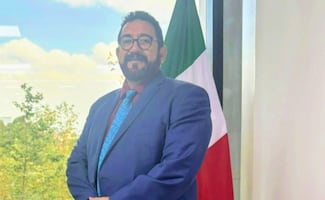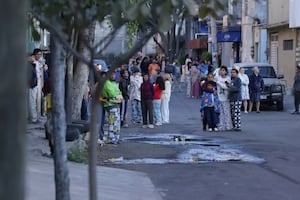Más Información

Ernestina Godoy nombra a Ulises Lara, fiscal especial en Investigación de Asuntos Relevantes; "estaremos trabajando por la justicia"

Sismo en CDMX: “Nos sacó un susto porque se movió como gelatina”, relata empleado de estacionamiento público

Sheinbaum pide a Segob ampliar protección a periodistas tras caso de Rafael León; "por encima de todo está la libertad de expresión"

Nombran a Miguel Hernández Velázquez inspector y contralor del Ejército, Fuerza Aérea y GN; destaca en la lucha contra el narco
The Mexican Cultural Institute
and the Embassy of Mexico have announced the exhibit 100 Years of Cartoons in El Universal: Mexico - United States as Seen by Mexican Cartoonists , that will take place from September 4 through October 30 at the at the Mexican Cultural Institute of Washington, located at 2829 16th St NW, Washington, D.C. 20009.
The exhibit presents a small, yet significant sample of political cartoons published throughout 100 years in leading Mexican newspaper El Universal revolving on important chapters of the development of political cartoon in Mexico .
The exhibition consists of 70 pieces—62 original cartoons—of outstanding aesthetic value by cartoonists who have portrayed the history of the country with special emphasis on Mexico-US relations , such as Andrés Audiffred , Eduardo del Río Rius , Helioflores , and Rogelio Naranjo . Most pieces came from the Caricature Museum of Mexico City , from the cartoonists themselves, and from private collectors.

100 Years of Cartoons in El Universal: Mexico - United States as Seen by Mexican Cartoonists
revolves around three main axes: The American cartoon , the cartoonists’ visions when portraying Uncle Sam , and American presidents . The exhibition also features the first cartoonists of El Universal and concludes with the great masters of the Mexican cartoon .
The exhibit celebrates half a century of the direction of EL UNIVERSAL by Juan Francisco Ealy Ortiz , CEO and President of the Administrative Board of the Mexican newspaper .
100 Years of Cartoons
in El Universal
has the support of the Foreign Affairs Ministry (SRE) , the Mexican Agency for International Development Cooperation (Amexcid) , the Mexican Cultural Institute of Washington D.C. , the Caricature Museum , and EL UNIVERSAL .
This Wednesday, August 4th, at 18:30 , the exhibit will be opened by Mexico’s ambassador in the U.S. , Martha Bárcena Coqui , and the editorial manager David Aponte .
This exhibit emerged as a book by the same name, that was presented in 2016 , within the commemorative program for the 100th anniversary of the newspaper.
“What we want with this exhibit in the U.S. is to present the vision of Mexican cartoonists regarding the United States,” explains the curator, Agustín Sánchez , in an interview.
He highlights that, “(…) this is the most important exhibit that has been organized outside Mexico about Mexican cartoons. More important because of the variety of artists included, and even more because 90% of the cartoons are originals .”
The first section of the exhibit is called “The first years,” and it collects some of the initial cartoons . The curator details that this section includes the first cartoon, which appeared in October 22nd, 1916 in this newspaper: “It is of the candidates for the Constituent Congress, those who would create the Constitution of 1917, among which was Félix Palavicini , who was the first director of EL UNIVERSAL .”
The next section focuses on the American comic strip , “The political cartoon comes from France, but the comic strip comes from the United States. Visitors in Washington will see a homage to Los Pilluelos , Charles Chaplin ; all these characters in original drawings, from original copies.”
The third section revolves around the iconic figure of Uncle Sam , “one of the symbols of universal iconography .”
The fourth section focuses on the presidents of the United States, from Harding to Trump , including portraits of Obama and Nixon , according to the curator.
The last section of the exhibit revolves around the masters of cartoons with a selection focused on Audiffred, Naranjo, and Helioflores.
Agustín Sánchez considers that currently, there is censorship and controversy regarding cartoons, which makes the exhibit more relevant.
“This exhibit is also very important in a moment of the history of humanity in which humor is not accepted . The New York Times just disappeared caricature (from its international edition). Cartoonists cannot be silenced ; we’re in a world where the politically correct is what’s correct; a world where there’s practically nothing uncensored. The world has evolved thanks to criticism , and Mexican journalism has evolved thanks to it. 50 years ago, there started to be criticism, and intelligent politicians have understood that it does not mean destruction, that it is fundamental for progress . And caricature in EL UNIVERSAL has had this role.”
The relationship between Mexico and the United States is a common topic in cartoons published in the country. Criticism is permanent , and issues such as nationalism and attacks against Mexicans are addressed, as well as cartoons alluding to Trump’s commentaries.
The Mexican Cultural Institute of Washington, D.C. is committed to enriching the relationship between Mexico and the United States by sharing Mexico's dynamic cultural past and present with the local community. The Institute showcases both the diversity and creative talent of Mexico’s culture, promotes artistic dialogue between Mexico and the U.S., and supports education for the arts.
sg
Noticias según tus intereses
[Publicidad]
[Publicidad]











